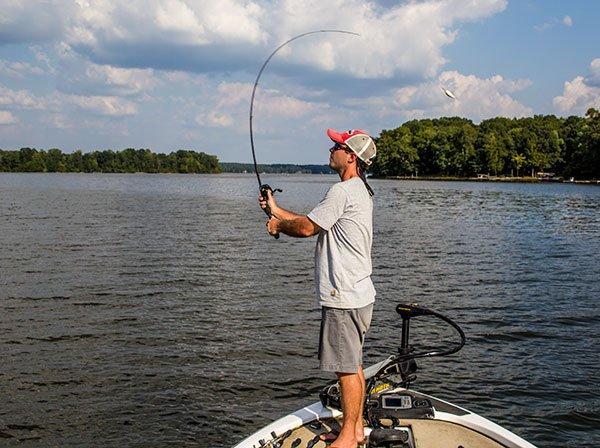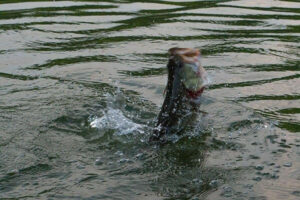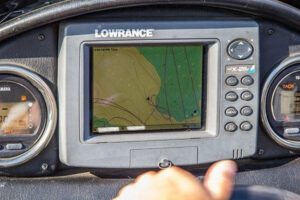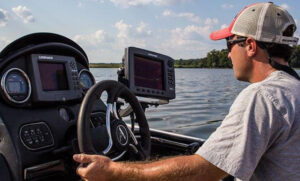Although it’s tempting to head to the backs of creeks and wing shallow crankbaits around during the fall, you can actually have a lot of success throwing deep crankbaits as well. One Georgia angler suggests throwing a crankbait for bass on creek ledges to catch some very impressive bass.
Two-time BFL All-American Kip Carter is one of the best crankbait fishermen I know. This guy has won tens of thousands of dollars on deep crankbaits and has taken many anglers’ money—including mine— in the fall. Instead of flocking to shallow water, he takes the deep creek ledges all to himself.
According to Carter, there are 6 reasons why you need to try cranking creek ledges this fall:
- No worries of the lake turning over
- Not all bass favor shallow water
- The shad get very predictable
- You can focus on contour lines others bypass
- Easy to develop a pattern
- Active fish are simple to pinpoint
1. The lake turned over? No big deal.
Every fall, shad make their annual migrations to the backs of creeks. Their journey to the shallow flats can be interrupted, however, by an angler’s worst nightmare—a lake turnover.
“Before a lake turns over, a thermocline sets up first,” Carter said. “When this happens, the bottom layer of water is heavier than the top layer. As the cooler fall weather lowers the temperature of the top layer, the two layers flip-flop—hence the name ‘turnover’.”
Once a turnover occurs, a poorly oxygenated layer of water rises to the top of the water column, which can wreak havoc on shallow bass fishing. By targeting creek channels in 15 to 25 feet of water, Carter avoids the headache altogether.
2. There are shallow bass… then there are deep bass
While other anglers head to shallow flats, Carter has productive creek channels all to himself with a deep crankbait.
We’ve all heard of resident fish in shallow backwater areas, but rarely do we discuss the presence of deep water resident bass. They’re just as prevalent, according to Carter.
“Just like you have bass that live shallow for their entire lives, I believe there are a lot of bass that never inhabit shallow water,” Carter said. “I really think there are some bass that even spawn offshore.”
Just because a bass lives in deep water doesn’t mean it won’t follow the shad migration. They’ll follow the shad from the river channels to the creek ledges in the fall, but that’s where many of them will stop. Carter believes some of the biggest bass stop short before chasing shad on the back flats of creeks.
3. Shad become very predictable
If you like to fish shallow in the fall, you’ve probably realized shad becoming active on the back creek flats sporadically throughout the day. Targeting creek ledges can provide more consistent action during your day on the water.
“More times than not, you can find huge wads of bait suspended even with the tops of the creek channels,” Carter said. “Just as we talked about with bass, there are some schools of shad that never make it to the flats. Instead, they’ll just congregate in the 15 to 25-foot depth range on the edge of these flats. You can’t miss ’em and bass have a field day with them.”
4. You’re targeting fish other anglers overlook
If you go to any lake during the fall, you’re likely to see the majority of anglers targeting shallow water areas. There may be plenty of bass in shallow water, but the deeper bass rarely see lures during this time.
Carter graphs a deep creek channel point to determine how to line up his casts.
“I start looking for creek channels that meet nearby river channels when the water reaches about 75 degrees,” Carter said. “Once I find these areas, I zigzag over the contour lines until I determine the depth range in which the bait is most active. I look for flat points, channel cuts and even humps in the creek channels. I have a lot more success on flatter structure than I do on sharp depth changes during the fall.”
When you become dialed-in on a productive depth range, the bass normally aren’t too bright. They rarely receive fishing pressure, so it usually takes just a few casts with a Strike King 5XD, a Strike King 6XD or a Strike King 10XD before you start producing a lot of bites.
5. Creek ledge bass can be very easy to pattern
“You can pattern these fish without much work, to be honest,” Carter said. “If you find them on one creek ledge point, there’s a great chance they’ll be on a bunch of other creek ledge points.”
Carter does warn, however, that sometimes it’s not just the structure the fish are relating to. Concentrating on specific depth ranges is also very productive throughout the fall.
“Oxygen content changes daily at every depth, so both the shad and bass will congregate at different depths each day,” Carter said. “If you’re getting a lot of bites in the 17-foot range, you need to specifically look for active bass in the same depth range throughout the day. Once you catch on to their depth, you will catch a lot of bass.”
6. Active fish aren’t hard to detect
We’ve all seen schooling fish on shallow flats during the fall, but it can be a very hit-or-miss strategy, especially for the tournament angler. Instead of solely watching for surface activity, paying attention to your electronics can play huge dividends.
Carter spends a lot of time graphing creek ledges to find active bass underneath bait balls.
“I don’t like to put all my eggs into one basket during the fall,” Carter said. “I idle—a lot—to find active fish on my graph. My first step is to find big balls of shad on my Lowrance, but you can’t stop there. Look for big streaks underneath the bait balls, because that’s indicative of a school of active bass busting through the bait. “
Instead of battling other anglers for shallow water fishing spots in the fall, spend some time searching for creek ledges to find large quantities of active, very catchable fish.
How do you plan on applying Carter’s technique this fall? Would you change anything about it? Comment below!















